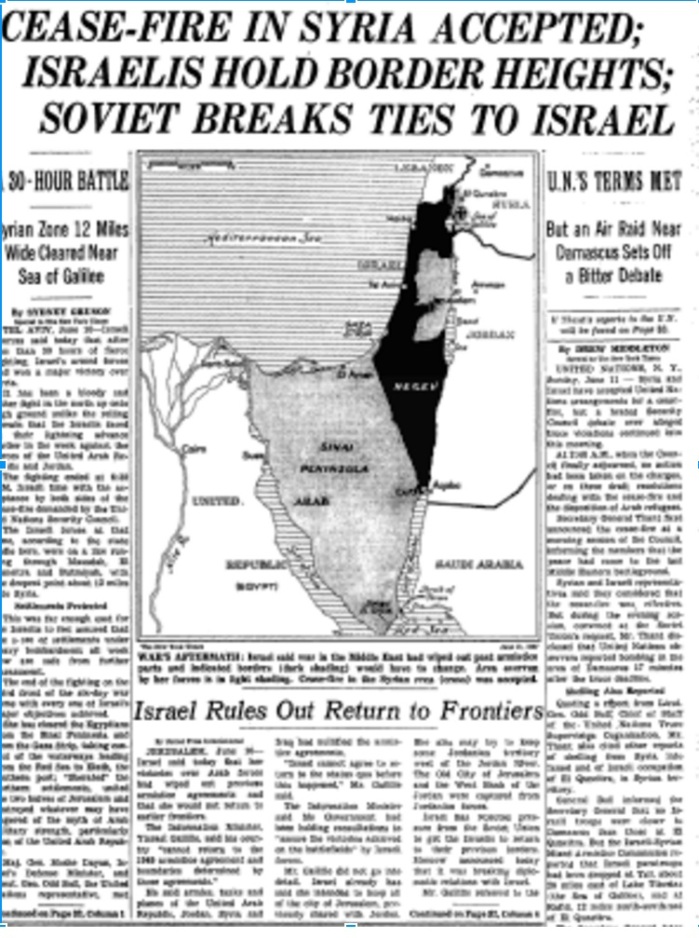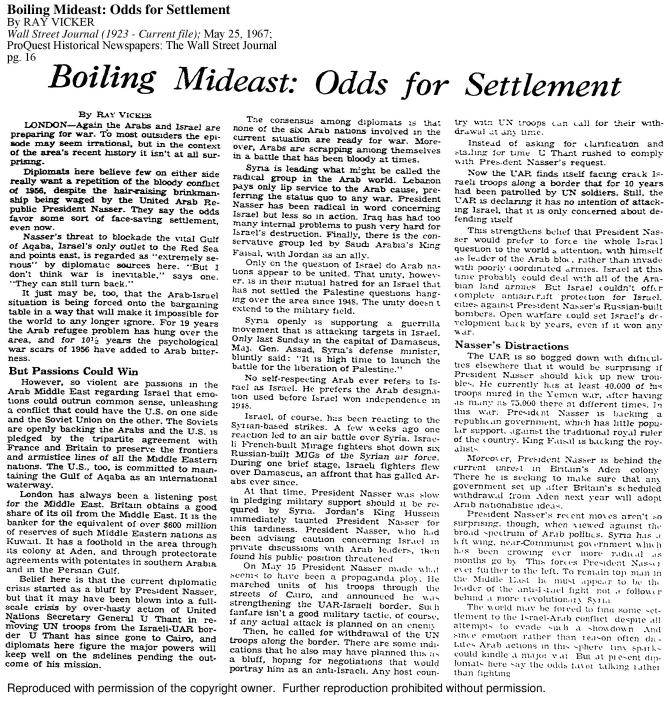Michael Scarlett and Eric Gorski
Annotated Bibliography

Military troops evacuating on the brink of the Six-Day War [Al-Jazeera]

Two US-made Israeli Super-Sherman tanks patrolling in East Jerusalem, June,1967 [AFP]
Annotated Bibliography
Source 1: Committee for Accuracy in Middle East Reporting in America
This first source is a non-biased, Encyclopedia Americana Annual 1968 based resource that we are using as a factual basis for the skewed arguments that occurred in the media after the 6 Day War. The short war began when Israel staged a sudden preemptive air assault that destroyed most of Egypt’s air force while it was still on the ground. A similar air attack by Israel struck the Syrian air force. Without cover from the air, the Egyptian army was left vulnerable and within three days the Israelis had achieved an overwhelming victory on the ground, capturing the Gaza Strip and the Sinai Peninsula. During the war, as many as 325,000 Arab residents fled to escape fighting in the area. Most crossed to the East Bank. What is still debated today is whether or not these residents were forced to leave, or did so out of fear on their own accord. Both sides argue different things, but the fact that many were displaced remains clear. Furthermore, Israeli law, passed in the 1950s to deal with Arab refugees from the 1948 war, hindered the return of many of these refugees as well. However, Prime Minister Levi Eshkol’s government, at United Nations’ urging, agreed to repatriate 40,000. The War marked the start of additional conflict between Israel and the Palestinians, since it put more than one million Palestinians in the occupied territories under Israeli rule. This was a refugee crisis with an added political components that still has ramifications in today’s relations.
Source 2: New York Times
June 15, 1967
Gruson, Sydney. “War Brings Problem for ’48 Palestinian Refugees.” New York Times 15 June 1967: Web. 1 Jan.
This article notes that the refugees from the Six Day War were not forced to leave, but rather they were acting on their own will. As the author notes, “…at no time during a number of long talks with Arabs in this area was anything said to support Arab charges at the United Nations that thousands had been forced to cross the Jordan River from the West Bank area occupied by the Israelis ….,” which explains this exact idea. This New York Times author is attempting to assert that Israel’s fighting against opposing forces did not create the refugee crisis, but rather it was a natural repercussions of the fighting.

Source 3: New York Times

Vicker, Ray . “Crisis Crux: Palestinian Refugees .” Wall Street Journal 2 June 1967: 10. ProQuest. Web. 6 Mar. 2016.
This article opens with a stunning quote from Ahmed Shukeiry, the Chairman on the Palestinian Liberation Organization: “We will continue guerrilla attacks in Palestine. We expect our action will lead to reactions from Israel. This will definitely lead to war; we know it; we accept it.” This quote illustrates the very self-aware intention of the Palestinian forces. They are provoking war knowingly and purposefully. The article places refugees at the center of the Middle Eastern crisis. In particular, the article considers how displaced Palestinians feel about Israel. It hypothesizes that, since 1948, the bitterness of those displaced has only grown, and become stronger with successive generations.

Vicker, Ray. “Boiling Mideast.” Wall Street Journal 25 May 1967: 16. ProQuest. Web. 6 Mar. 2016.
This article provides some geo-political context for the Six-day War. We can see tensions rising and animosity growing, but there is still a sense that a military attack is inappropriate. The author of the article writes: “Few on either side really want a repetition of the bloody conflict,” which is contradictory to what the PLO chairman said just a few weeks after this article was written.

Melloan, George. “Israel’s Biggest Problems Now Internal.” Wall Street Journal 19 June 1967: 10. ProQuest. Web. 6 Mar. 2016.
This Wall Street Journal article examines the aftermath of the Six-day War, and the new emerging Israeli identity after having defeated the well-resourced Palestinian coalition. This identity is incredibly diverse and multiethnic, but also very inward. Having thwarted the efforts from Arab countries to conquer the Israel, the Israeli government now had the opportunity to focus on internal dilemmas.
Links:
- http://www.sixdaywar.org/content/refugees.asp
- http://timesmachine.nytimes.com/timesmachine/1967/06/15/issue.html
- http://query.nytimes.com/mem/archive-free/pdf?res=9A06E0DB163FE53BBC4952DFB066838C679EDE